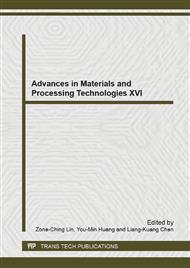p.201
p.209
p.214
p.222
p.230
p.239
p.245
p.253
p.260
Effect of Optical Properties Characteristic Polymethylmethacrylate Using UV Laser Direct-Structuring
Abstract:
Polymethylmethacrylate (PMMA) material has excellent characteristics, such as being light weight, low cost, ease of machining, and optical quality, which are useful in numerous applications such as backlit LCD display panels, lens optics, and other photoelectric fields. Laser machining of polymerization material results in a superior machining quality, high accuracy, high speed, and high reproducibility, produces a small variety of products, reduces mold costs, and enables the rapid manufacture of products based on complex graphics by processing different depths and widths of the 3D structure. This paper presents the fabrication of symmetrical array microstructures on PMMA material by using a UV laser system. The PMMA material dimensions and thickness were 20 x 20 mm and 1 mm, respectively. Regarding the machining quality, the laser pulse energy, pulse repetition frequency, and fill spacing were adjusted. For the experiments, a semiconductor laser source (635 nm/5 mW/TEM00) and a beam profiler were used to measure the characteristics of a laser beam passing through the microstructures. The microstructure pitches and morphologies also affected the light uniformity. After laser machining, the surface morphology and the light transmittance were measured using a spectrophotometer.
Info:
Periodical:
Pages:
230-236
Citation:
Online since:
May 2014
Authors:
Price:
Сopyright:
© 2014 Trans Tech Publications Ltd. All Rights Reserved
Share:
Citation:


